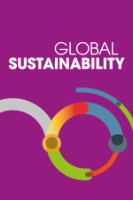1. Introduction: Understanding a polycrisis through systems thinking
The world today faces multiple interconnected crises, including climate disruption, social and economic inequality, economic instability, geopolitical tension, and armed conflict. We are leaving the era of the mean, when tomorrow does not usually deviate from the average, and entering the era of the standard deviation, when tomorrow often deviates from the average and even becomes an outlier or perhaps dominated by black swans (Taleb, Reference Taleb2007). The term ‘polycrisis’ has been recently revived to refer to a series of complex dynamic processes – experienced as crises – whose interactions amplify the impacts of any individual crisis and collectively intensify the challenges posed to humanity (Lawrence et al., Reference Lawrence, Homer-Dixon, Janzwood, Rockstöm, Renn and Donges2024; Swilling, Reference Swilling2013; Tooze, Reference Tooze2022). Such complex interactions among different systems have the potential to cause paralysis in governance and action, resulting in either a stubborn adherence to the status quo or the issuance of untenable promises and ineffective interventions (Galaz, Reference Galaz2022; Hamant, Reference Hamant2024a, Reference Hamant2024b; Kahneman, Reference Kahneman2011; Meadows, Reference Meadows2008; World Economic Forum, 2023) – both of which risk creating societal collapse or catastrophe (Janzwood & Homer-Dixon, Reference Janzwood and Homer-Dixon2022). It is therefore important to advance the conceptual understanding of (a) how events in one system can cause cascading effects in others, exacerbating vulnerabilities and limiting the effectiveness of conventional policy responses and (b) how to enable diverse actors across sectors to better align around the system archetypes embedded in the global polycrisis, and navigate the complex challenges ahead.
We follow the Homer-Dixon et al. (Reference Homer-Dixon, Walker, Biggs, Crépin, Folke, Lambin, Peterson, Rockström, Scheffer, Steffen and Troell2015) definition of a crisis as ‘a sudden event or a closely connected series of events within or across social-ecological systems that significantly harms, in a relatively short period of time, the well-being of a large number of people’ (p. 2). Further, the term polycrisis refers to an emergent risk that arises from the interaction of crises in multiple systems (Janzwood & Homer-Dixon, Reference Janzwood and Homer-Dixon2022). As Janzwood and Homer-Dixon (Reference Janzwood and Homer-Dixon2022) highlight, a polycrisis is highly dynamic and may play out at a regional, continental or global scale. Five core properties distinguish polycrises from other risks: extreme complexity, high nonlinearity, transboundary causality, deep uncertainty, and synchronized inter-systemic behaviour. The dynamic complexity of the polycrisis arises from its interconnected and multilayered nature, where multiple, concurrent crises interact in ways that risk amplifying their individual and collective effects. Finally, the global polycrisis is planetary in scale and has the potential for ‘irreversible and catastrophic degradation of humanity's prospects’ (see Table 1 in Janzwood & Homer-Dixon, Reference Janzwood and Homer-Dixon2022, p. 6). Here, we will refer to polycrises in a general sense, where outcomes may be regional or global but potentially reversible, without assuming catastrophic and irreversible planetary consequences.
Lawrence et al. (Reference Lawrence, Homer-Dixon, Janzwood, Rockstöm, Renn and Donges2024) have suggested pathways by which stresses and triggers of a crisis in one global system, such as the climate system, might lead to new crises in related systems, such as the food system, or accelerate other ongoing challenges, for example, biodiversity loss, with potentially catastrophic consequences (see also Barnosky et al., Reference Barnosky, Matzke, Tomiya, Wogan, Swartz, Quental, Marshall, McGuire, Lindsey, Maguire, Mersey and Ferrer2011). However, a key challenge in understanding and addressing polycrises lies in defining system boundaries and tracing complex causal chains under deep uncertainty. This uncertainty also complicates efforts to identify effective intervention points. To this end, system archetypes are a valuable analytic tool, as they can offer systemic insights while simplifying complexity. As a crisis always results from a situation of prolonged trouble (‘stresses’ sensu Lawrence et al., Reference Lawrence, Homer-Dixon, Janzwood, Rockstöm, Renn and Donges2024), using system archetypes can help by moving the conversation away from ‘solving’ the crisis (i.e., the dead-end, often the symptoms of an underlying condition) to assessing and tackling what generated the trouble (focusing on what systems thinkers refer to as the underlying causal structure). As we enter a polycrisis, this becomes even more pertinent: the risk is to focus on multiple symptoms – or even the most spectacular one – instead of identifying and addressing the root causes of the initial trouble.
Last but not least, mapping crisis interactions using system archetypes offers insights into how the relationships between certain variables or parameters may incorporate feedback loops dominating the observed behaviour. By studying such maps, leverage points can be identified to shift the behaviour towards more desirable outcomes. For instance, changing threshold values, strengthening desired loops, creating new loops, shortening or prolonging delays, or redefining system goals and underpinning paradigms (Meadows, Reference Meadows1999).
Against this background, this paper aims to illustrate the potential of systems thinking through the use of system archetypes and to contribute to the polycrisis literature by advancing the conceptual understanding of how multiple crises are interlinked. Specifically, we explore three system archetypes and translate them into polycrisis patterns.
System archetypes have been used in other contexts. For instance, Moallemi et al. (Reference Moallemi, Hosseini, Eker, Gao, Bertone, Szetey and Bryan2022) applied system archetypes to illustrate interrelations between the 17 Sustainable Development Goals. Our contribution differs from their work in that we here represent how multiple crises, rather than goals, interact in recognizable patterns, as well as how these interactions require an extension of the structure of conventional system archetypes. Other studies have applied system archetypes to more specific themes, for example, related to urban dynamics (see Kidwai & Saraph, Reference Kidwai and Saraph2016). The application of system archetypes to the polycrises context also relates to the framework ‘Syndromes of Global Change’ (Petschel-Held et al., Reference Petschel-Held, Block, Cassel-Gintz, Kropp, Ludeke, Moldenhauer, Reusswig and Schellnhuber1999) that describes recurring patterns of environmental and socio-economic interactions that lead to sustainability challenges. However, while the ‘Syndromes of Global Change’ offer context-specific diagnostic frameworks that describe social-ecological dynamics, the system archetypes are more generalizable, offering transferable insights across domains. Furthermore, Søgaard Jørgensen et al. (Reference Søgaard Jørgensen, Jansen, Avila Ortega, Wang-Erlandsson, Donges, Österblom, Olsson, Nyström, Lade, Hahn, Folke, Peterson and Crépin2024) adapted the ‘evolutionary traps’ concept, i.e., when previously adaptive traits or behaviours become maladaptive due to environmental changes, to a global human context in order to study polycrises. They identify 14 such ‘Anthropocene traps’ and present their characteristics. In contrast to our contribution, these traps were not linked to conventional system archetypes and the authors did not explicitly lay out the system structures underlying the respective behaviours that they present (note that here, as in the rest of the paper, the term ‘behaviour’ refers to the concept as used within the system dynamics tradition, i.e., the dynamic patterns of change in variables over time within a system – see, e.g., Forrester, Reference Forrester1961; Meadows, Reference Meadows2008; Sterman, Reference Sterman2000). We here open new avenues for understanding these Anthropocene traps and invite their mapping to the polycrisis patterns proposed below.
In the following sections, we explain what system archetypes are and illustrate how three such archetypes can be applied and adapted to a polycrisis context. To highlight each system archetype’s particularities for a polycrisis context, we suggest a ‘polycrisis pattern’. In Section 4, we discuss the potential of the polycrisis patterns for exploring robust policies and processes addressing the root causes, rather than the symptoms, of entangled, co-occurring global issues. We end by reflecting on how archetypical system behaviours are driven by unquestioned assumptions and values of a dominant paradigm in society, notably the focus on efficiency as the only aim (‘efficiency trap’). By becoming aware of and better aligned around the system archetypes embedded in polycrises, we may be able to better understand, assess and navigate the complex challenges ahead.
2. From system archetypes to polycrisis patterns
System archetypes are recurring patterns of behaviour that are caused by certain system structures (Forrester, Reference Forrester1961; Kim & Anderson, Reference Kim and Anderson2007; Mandl, Reference Mandl2023; Meadows, Reference Meadows1982, Reference Meadows2008; Senge, Reference Senge1990; Stroh, Reference Stroh2015; de Vries, Reference de Vries2024). Originating in the field of system dynamics, they are common across various domains of applications. Although most systems cannot be reduced to such repeated patterns, these ideal-type simple models provide a framework for illuminating their underlying structures and the often counterintuitive behaviours resulting from them. We propose that system archetypes can provide a common language and facilitate a structured approach to studying and addressing a polycrisis.
In alignment with our aim of illustrating the potential of system archetypes in polycrisis analysis, we explore the utility of three polycrisis patterns: Converging Constraints (Limits to Growth archetype), Deepening Divides (Success to the Successful archetype), and Crisis Deferral (Policy Resistance archetype). This selection is by no means exhaustive. Rather, it includes a limited collection of system archetypes to begin the exploration, pragmatically chosen to fit the scope and length of an Intelligence Briefing. Our choice of system archetypes covers three out of four of Wolstenholme’s ‘core set of archetypal structures’ (Wolstenholme, Reference Wolstenholme2003), offering a foundational lens to explore systemic challenges. Of the multiple system archetypes in the literature, we chose a subset that portrays distinct characteristics.
Furthermore, following from our sustainability focus, the selected system archetypes effectively capture key dynamics of polycrises with potentially global and (sub-)catastrophic consequences: Converging Constraints (Limits to Growth) reflects the increasing strain of global limits (planetary boundaries and resource depletion, as articulated by Meadows (1972) and Daly's ‘full world-empty world’ framing (Daly, Reference Daly2005)). Deepening Divides (Success to the Successful) highlights the role of inequities, a fundamental concern in sustainability science, as emphasized by Clark and Harley in their synthesis of sustainability science (2020): addressing equity is critical for understanding and mitigating the unequal burdens and feedbacks in a polycrisis. Furthermore, Crisis Deferral (Policy Resistance) captures the pervasive challenge of superficial interventions that fail to address underlying systemic issues, echoing themes like the efficiency trap: how the pursuit of efficiency in various systems – economic, industrial, agricultural – has led to vulnerabilities (a theme widely explored in the resilience thinking literature and beyond, see, e.g., Holling, Reference Holling1973; Meadows, Reference Meadows2008; Walker & Salt, Reference Walker and Salt2006). This third system archetype hints at the need for transformative, not merely reactive, solutions.
Taken together, these three system archetypes constitute an essential vocabulary of recurring patterns that support elucidating causal structures and crisis interactions. Once this vocabulary is familiar, it can be expanded with other system archetypes, such as Escalation (thus completing coverage of the core set of Wolstenholme, Reference Wolstenholme2003), Tragedy of the Commons, Shifting the Burden, Drifting Goals and Growth and Underinvestment (see, e.g., Kim & Anderson, Reference Kim and Anderson2007). Each system archetype used in this paper is presented following a set of diagramming conventions, described in Box 1.
Box 1. How to read the figures
The figures in this article integrate causal loop diagrams (CLDs) with additional elements to illustrate system archetypes and the interactions between multiple crises. It is important to note that these diagrams serve as illustrative examples based on a series of assumptions about cause-and-effect relationships, similar to the use of influence diagrams by Lawrence et al. (Reference Lawrence, Homer-Dixon, Janzwood, Rockstöm, Renn and Donges2024). While most of the depicted relationships are well-established and some references are provided as pointers, some may touch on areas that warrant further quantitative analysis and research. Furthermore, the direction and strength of relationships may vary across domains. However, such detailed empirical validation falls beyond the scope of this paper.

3. Applying system archetypes to a polycrisis: Polycrisis patterns
3.1. Converging Constraints (the Limits to Growth archetype)
The Limits to Growth archetype describes a situation in which a growth or decline is generated by a self-reinforcing feedback process until the system confronts some kind of limit. The limit constrains further expansion or contraction by acting as a balancing counterforce. Depending on the nature of the limit, especially whether there are significant delays in the system, the resulting behaviour could be a smooth levelling off of the increase in the variable of interest, fluctuations (oscillations), or some kind of overshoot and collapse. This system archetype has also been referred to in the literature as Limits to Success (Kim & Anderson, Reference Kim and Anderson2007).
As an overarching example, the last centuries of growth in production, consumption, and trade of goods and services have contributed to an overall improvement in the well-being of much of humanity, supporting unprecedented levels of economic and population growth. This growth of economic activities, referred to as ‘Size of operations’ in the generic CLD shown in Figure 1, has created revenues that directly supported constant increases in productive capacity (‘Investment’). The increased productive capacity has further contributed to the increase of production and consumption in a self-reinforcing manner, illustrated by the reinforcing loop ‘R1’ (in Figure 1). However, the size of operations becomes more difficult to manage as it increases and confronts constraints, resulting in increased ‘Operation Constraints’ which then reduce further growth (the negative link from ‘Operation Constraints’ to ‘Size of Operations’). At the same time, these constraints are further exacerbated by ‘External pressures’, in this case finite resources or the limited capacity of the ecosystems to absorb pollution, amongst others. This creates a balancing loop (‘B1’) which prevents the size of operations from growing indefinitely (similar dynamics are presented as a more detailed CLD in Collste et al., Reference Collste, Cornell, Randers, Rockström and Stoknes2021). This slowing down in production may already be generating a crisis in some parts of the globe (Crisis A).
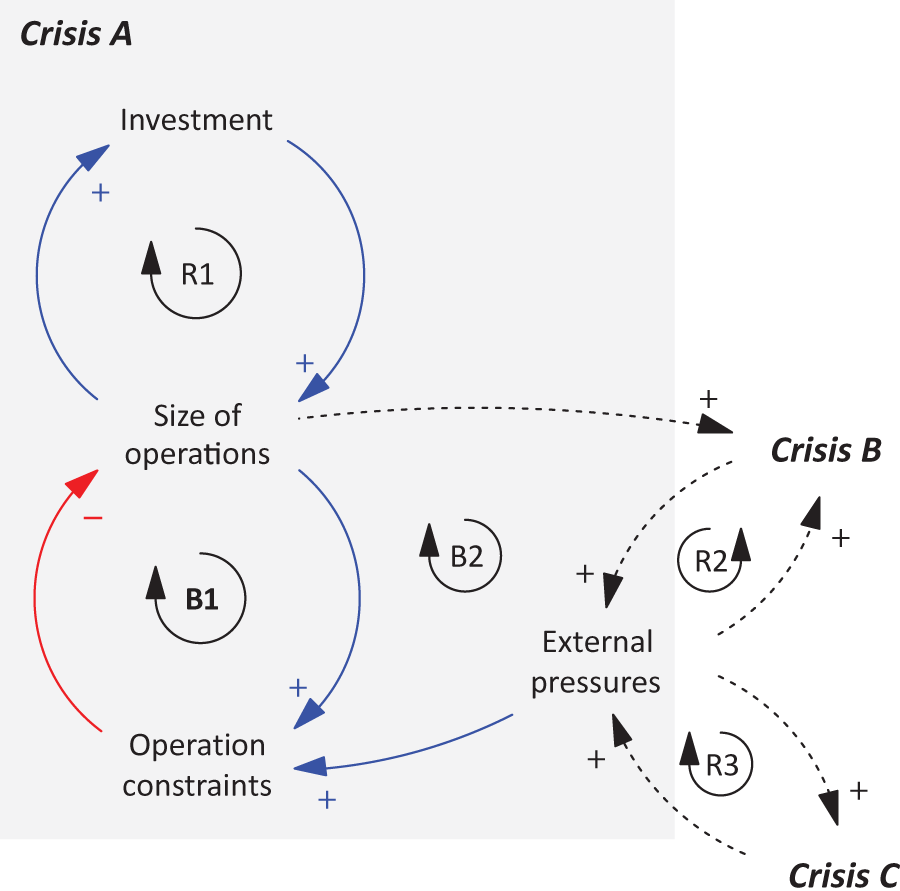
Figure 1. Limits to Growth archetype as a polycrisis pattern: Converging Constraints. This diagram portrays how converging limits to growth from various crises (Crisis B and Crisis C) affect the unfolding of the original crisis (Crisis A).
Applied to a polycrisis context, we begin by acknowledging that multiple subsystems exhibit a Limits-to-Growth dynamic. However, the emergent risk of their interaction lies in the respective limits or constraints converging or strengthening each other (‘R2’ and ‘R3’ loops in Figure 1). In addition, growth in the central variable of one subsystem might trigger crises in other systems, which may, in turn, further increase the external pressures, creating a new balancing loop that feeds back to the initial system (B2).
While this generic CLD needs to be adapted for each particular context, as here the links between the crises can only be implied on a very high level of abstraction, several hints for leverage points are already apparent. For instance, considering the implications of the reinforcing growth in size of operations on other subsystems is a first step towards trying to dismantle or mitigate the effects of that link. This could involve analyses of tipping points beyond which the size of operations acts as a trigger for other crises. It may also require managed decoupling of the various subsystems or even a managed slowdown or halt in the growth of the ‘Size of operations’ before the external pressures kick in (rather than letting the decline be a deterministic consequence of uncontrolled external pressures). Finally, analyses of which external pressures converge in multiple systems and of the processes by which these influence each other (links in R2 and R3) could reveal efficient ways to reduce these pressures simultaneously, e.g., via what has been referred to as ‘multisolving’ (Sawin, Reference Sawin2024)). Box 2 illustrates Converging Constraints in relation to the production and use of combustion engines.
Box 2. Example of Converging Constraints
Combustion engines and production, Figure 2
Among the most profound and beneficial inventions of the Industrial Revolution were the steam engine and the combustion engine. These technologies create a reinforcing feedback loop resulting in exponential growth of production (‘Production capacity’ as ‘Production revenue’ is being reinvested) and ‘Use of combustion engines’. Combustion, however, through ‘CO2 emission’, changes the composition of Earth's atmosphere, increasing carbon dioxide. Human-caused emissions of carbon dioxide increased exponentially from 9 million tonnes in 1750 to 37 billion tonnes in 2022 and are still growing (Global Carbon Budget, 2023). This reinforcing feedback loop of producing and using internal combustion engines has resulted in an increase in carbon dioxide concentration from 275 ppm (parts per million) in 1750 to 426 ppm today, an increase of 55% in just over 270 years (Scripps Institution of Oceanography, UC San Diego, 2024). The consequence of this reinforcing feedback loop (R1) is an increase in global average temperatures and corresponding ‘Temperature anomalies’ (in this example, we only include emissions from combustion engines, mindful of this being a vast simplification). The constraining factor here is ‘running out of’ the climate conditions to which our civilizations are accustomed, which will imply, among others, various ‘Operation constraints’ not only in systems critical for human subsistence but, in the short-term, also in the very production of engines (‘Production capacity’, B1). The last time atmospheric carbon dioxide concentration was above 426 ppm was approximately 14 million years ago – long before human civilizations evolved (Scripps Institution of Oceanography, UC San Diego, 2024). Sooner rather than later, the production and use of internal combustion engines and other combustion as well as sources of carbon emissions will have to stop if we want to avoid devastating consequences.
In the context of a polycrisis, the increase in global average temperatures may, ironically, amplify the use of combustion-based technologies (e.g., for heating or cooling devices) to mitigate the effects of crises in other subsystems (not shown in the Figure), while also accentuating the driving conditions of those crises (R2). For instance, in some cities, where summer temperatures rise above 40°C, air conditioning becomes essential for preventing major health crises. However, these systems typically rely on electricity generated from fossil fuels, creating a cycle of increased energy demand – often still sourced from fossil fuels. These ‘Energy system pressures’ may trigger energy crises. Such crises may themselves behave according to a Limits to Growth archetype (for instance, where use is constrained by the limited capacity of the network or lack of fuels). These various ‘Energy system pressures’ may also amplify ‘Adaptation constraints’, leading to further increases in temperature anomalies and operation constraints in the production of combustion engines (B2). For instance, the increased use of combustion engines might deter from more costly infrastructure investments in alternative energy systems and, as oil depletes or becomes more expensive, this indirectly erodes the longer term capacity for adapting to temperature rise, when supplying the required energy becomes difficult and/or costly. Meanwhile, in cooler areas, the rising temperature may reduce energy use for heating, highlighting the complexity of a situation where limits from multiple subsystems are converging (not shown in Figure). ‘Health system pressures’ from increased ‘Temperature anomalies’ may also further increase ‘Adaptation constraints’, e.g., by limiting working times due to extreme heat or available workers (R3). Finally, an increased use of combustion engines may also amplify ‘Geopolitical tensions’, for instance, in so far as cheap and accessible oil becomes a scarce resource. Such tensions could, in turn, increase the ‘Adaptation constraints’, by limiting cooperation among countries (B3).
As the crises in other systems are not fully mapped, the polarities shown in the B2, B3, and B4 loops are uncertain, as they are only implied by several assumptions in our narrative. The polarities of the links, as well as the nature of those loops, may be different when more intermediate variables are added.
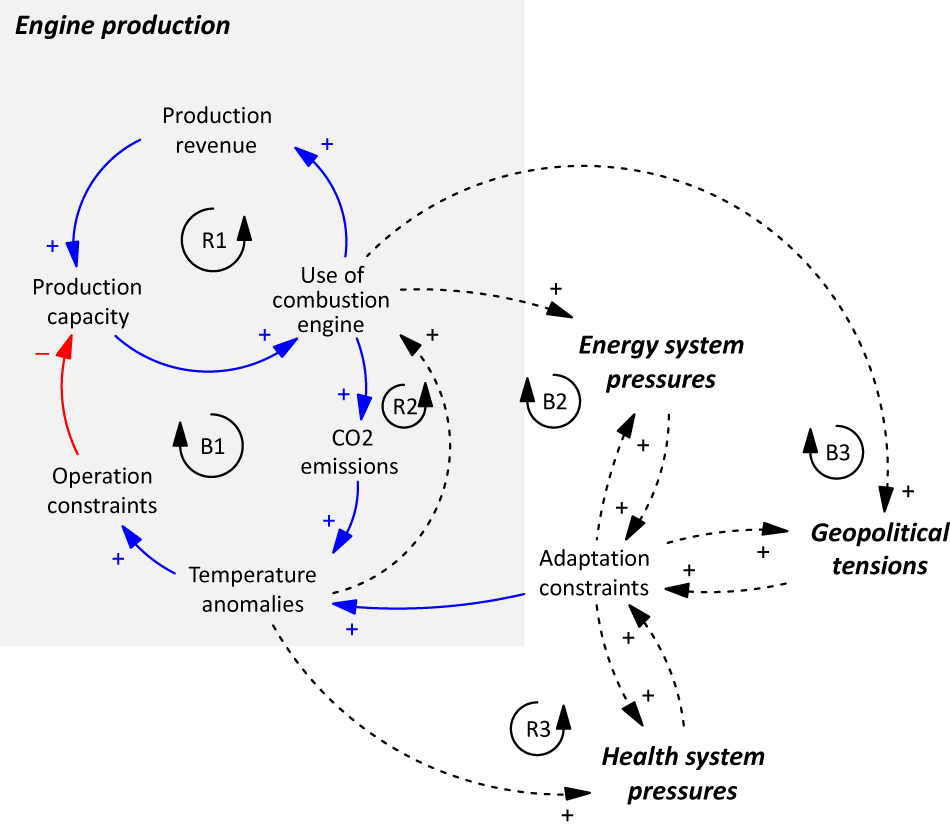
Figure 2. Combustion engines and production. See the caption for Figure 1 on how to read these diagrams.
This simplified CLD is already useful in providing several insights for addressing the polycrisis. First, the shape of the growth in combustion engine use will depend on the relative intensity of the various reinforcing and balancing loops affecting it. This growth may quickly decline when other crises add new (and possibly fast) balancing loops, while also eroding adaptive capacity and increasing undesirable reinforcing effects, such as in connection to the health system (R3). But the growth may also be brought smoothly to a halt close to a maximum carrying capacity, by breaking the links between the use and other crises. As an example, if the ‘Production revenue’ from combustion engines is invested in the production capacity for non-renewable energy sources, then both the links to energy system pressures and geopolitical tensions potentially no longer hold. In turn, the ‘Adaptation constraints’ can be reduced, alleviating ‘Temperature anomalies’ and ‘Health system pressures’, therefore reversing the direction in which the R3 loop works.
3.2. Deepening Divides (the Success to the Successful archetype)
The Success to the Successful system archetype entails two actors, or activities, that need the same limited resources. As a decision is made to allocate more resources to one actor, it reinforces that actor’s chance of succeeding while depriving the other actor of necessary support. Over time, the success of one actor increases while the other is destined for failure. Another name for this system archetype is Path dependency, which highlights that the observed diverging behaviours of two actors or activities are driven by reinforcing cycles stemming from an initial decision point. These reinforcing loops create bifurcated trajectories that become difficult to alter over time.
The Deepening Divides polycrisis pattern captures the dynamic where existing advantages (such as wealth, resources, and power – ‘Success of X’ in Figure 3) enable individuals, groups, or nations to further consolidate and expand their relative advantages in the face of various crises, creating a non-level playing field (‘Allocation to X vs. Y’ causing an increase in ‘Resources to X’, which in turn reinforces the ‘Success of X’, feeding back to ‘Allocation to X vs. Y’ in Figure 3). Conversely, those who start with disadvantages (poverty, lack of resources, marginalisation) face growing challenges that further entrench their disadvantaged position (an increase in ‘Allocation to X vs. Y’ causing less ‘Resources to Y’ which cause less ‘Success of Y’, which feeds back to ‘Allocation to X vs. Y’). That is, the already inequality-driving dynamics of Success to the Successful archetype, which we can recognise in today's social divide (e.g., ‘Crisis A’), is here exacerbated when other crises trigger even faster allocations towards the successful and away from the disadvantaged (the link from Crisis B to ‘Allocation to X vs. Y’ in Figure 3). An example could be a switch away from democracy towards more authoritarian or oligarchic systems that sharply increase the ‘Allocations to X vs. Y’.
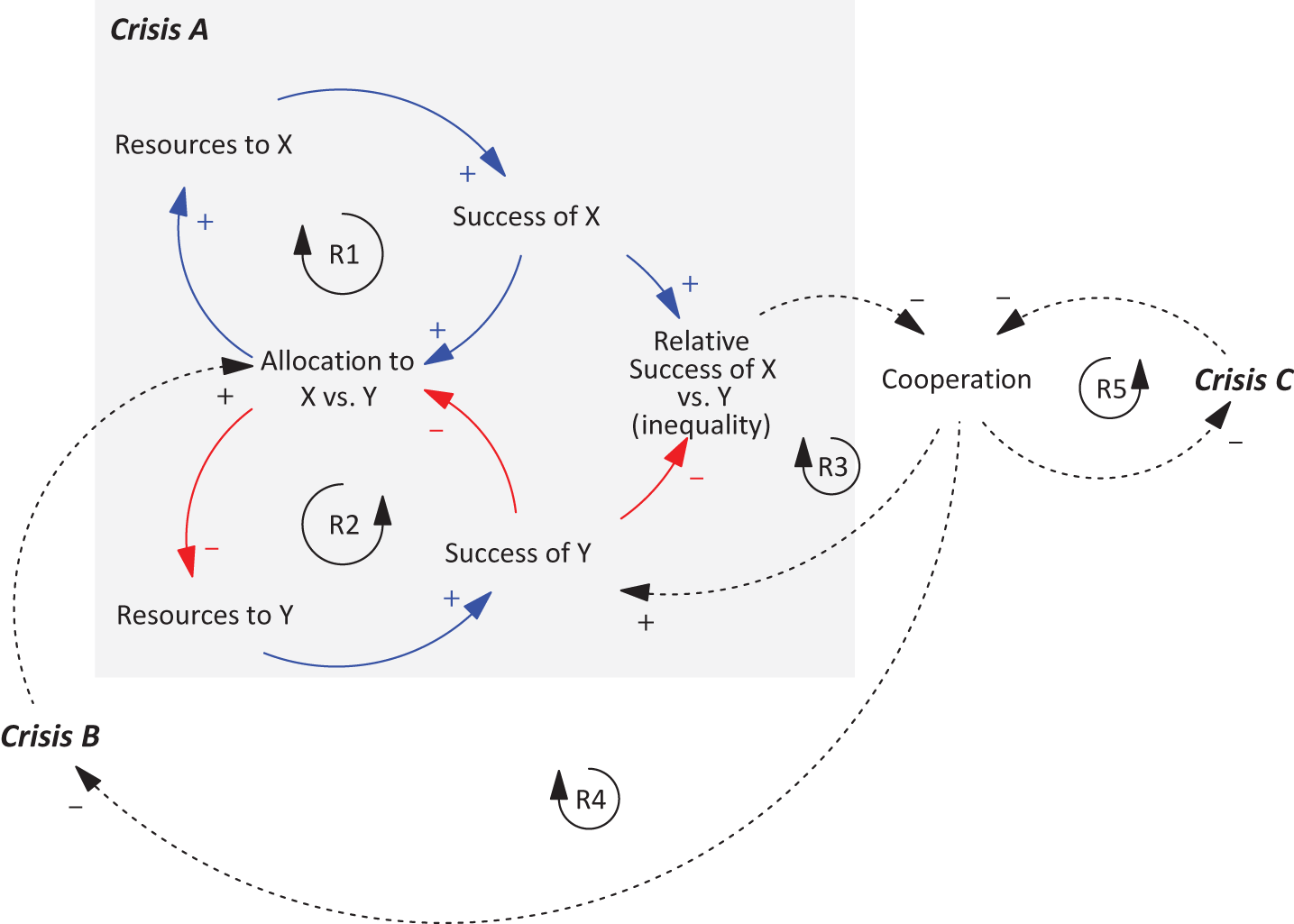
Figure 3. Success to the successful archetype in a polycrisis context: deepening divides. See the caption for Figure 1 on how to read these diagrams.
These divides could exacerbate the multiple, interconnected crises that are typical of a polycrisis in two major ways. First, inequalities correlate with worse outcomes across a range of social and health indicators, including life expectancy, mental illness, social mobility, and trust, undermining societal well-being (Wilkinson & Pickett, Reference Wilkinson and Pickett2009). Second, inequalities across large population groups or nations disable the opportunity for cooperation and collective action (Blind, Reference Blind2006; Keele, Reference Keele2007; Reiersen, Reference Reiersen and Magnussen2019; Wilkinson & Pickett, Reference Wilkinson and Pickett2009), not only concerning the inequalities (reinforcing R3 loop) but also to the unfolding crises in other subsystems (R4 and R5, with respect to Crisis B or Crisis C, respectively). It is precisely the reinforcing nature of these additional loops that create the character of the Deepening Divides pattern in a polycrisis context.
Interventions to counteract this system behaviour include tackling the inequalities head-on by providing more equitable access to resources and opportunities. Interventions could also target vulnerable communities by investing in their ability to adapt or transform in response to shocks (this relates to the concept of ‘general resilience’, see, e.g., Carpenter et al., Reference Carpenter, Arrow, Barrett, Biggs, Brock, Crépin, Engström, Folke, Hughes, Kautsky, Li, McCarney, Meng, Mäler, Polasky, Scheffer, Shogren, Sterner, Vincent and Zeeuw2012). They may also require critical reflection and commensurate policy action to find ways to compensate allocation disadvantages when responding to crises. For instance, in an extreme climate event emergency, there may be a tendency to first protect critical infrastructure which may also be located in more wealthy neighbourhoods, at the expense of more vulnerable settlements. Creating response policies that particularly integrate such equity considerations could be a way to escape the Deepening Divides pattern in the context of polycrisis. A further example is presented in Box 3.
Box 3. Example of Deepening Divides
Social Divides and Climate Change, Figure 4
Wealthier nations and individuals can afford adaptive technologies and resilient infrastructures to counteract the impacts of climate change. This could also decrease their incentives to invest in mitigation, which leaves everyone worse-off in the long-term. In contrast, poorer communities are often more vulnerable to climate-related disasters, which further exacerbate their economic and social challenges and deepen social divides (Collste et al., Reference Collste, Henriksson, Akbik, Crépin, Folke, Lerpold, Lindkvist, Malmer, Ordenes, Rocha, Schill, Schultz, Galaz and Collste2022; Kotz et al., Reference Kotz, Levermann and Wenz2024). The future well-being of such poorer communities also depends more heavily on the global efforts to mitigate climate change, as they have limited resources to adapt. In the context of a polycrisis, the inequitable impacts of climate change could trigger other crises, such as famine, displacement, and social and political unrest. Such crises could, in turn, not only reinforce existing inequalities but also stand in the way for international collaboration to tackle various crises – including addressing climate change (thus completing the loop) (results from Arezki et al. (Reference Arezki, Imam, Kpodar and Camara2025) suggest that unequal impacts and existing inequalities may hinder effective international cooperation; Conevska, (Reference Conevska2021), highlights how established cooperative frameworks can enhance resilience and support recovery efforts). These dynamics are presented in Figure 4 and outlined below.
Figure 4 illustrates the abovementioned links between a social divides crisis (the grey area on the left) and a climate change impact crisis (the grey area on the right). With high levels of production already being established in high-income countries (HIC) (‘Production in HIC’ in the upper left of Figure 4), follows more foreign and domestic investments (‘Investments allocated to HIC over LIC’). These investments further increase the ‘Production Capacity in HIC’, reinforcing the effect, R1. In the meantime, low-income countries (LIC) are lagging behind based on the same path-dependency dynamics in loop R2. While this diagram focuses on the path dependency between countries’ developments, this is only a subset of larger systems and theories. There are also other dynamics at play, notably the theory of economic convergence of LIC catching up with HIC.
The ‘Wealth of HIC’ is affected by the ‘Production in HIC’. Access to capital and investments has also incorporated that HIC’ infrastructure is more resilient and that they have better access to adaptive technologies compared to their low-income counterparts (‘Resilience of HIC's infrastructure’ and ‘Resilience of LIC's infrastructure’, respectively). The higher resilience and more adaptive technologies, in turn, make HIC less vulnerable to climate-related disasters, while LIC are more vulnerable – they may be hit harder, and their already limited wealth may be more affected. This difference in vulnerability, in turn, makes them more impacted. This is reflected in the ‘Unequal effects of climate crisis’ variable on the right of the Climate change field. In turn, these divergent climate effects also play out in other areas, reflected in the links to ‘(Unequal effects of) Food crisis’ and ‘(Unequal effects of) Water crisis’ on the right of the Climate change field. When crises affect nations unevenly, differing perspectives and degrees of impact can make international cooperation more challenging. Limited cooperation, in turn, makes it harder to address initial disparities (as shown in the link from ‘International cooperation’ to ‘Investments allocated to HIC over LIC’).
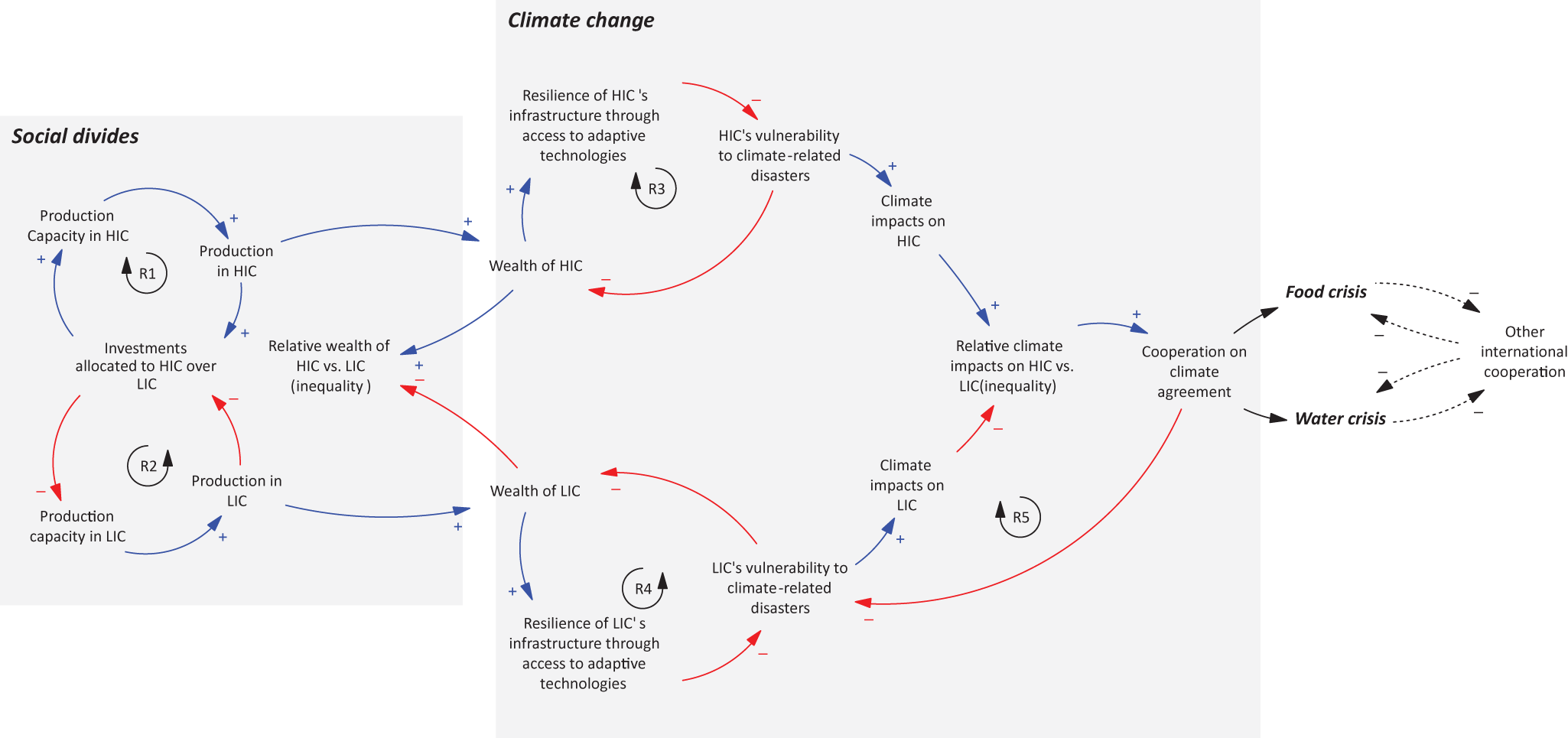
Figure 4. Deepening divides in the context of climate change. LIC = low-income countries; HIC = high-income countries. See the caption for Figure 1 on how to read these diagrams.
As one leverage point in a polycrisis context, a critical question is whether international cooperation on various crises, especially via foreign investments and aid, can be disconnected from the unequal effects experienced by HIC vs. LIC. In other words, can there be policy mechanisms put in place to sustain or even increase cooperation even in difficult situations? Further, what are the ways by which the diverging paths of success of HIC relative to LIC could be brought together by fostering success interdependencies? Mapping more detailed crisis interactions in specific contexts might provide additional insights into possible interventions.
3.3. Crisis Deferral (the Policy Resistance archetype)
In the Policy Resistance system archetype, a problem is ‘solved’ by some quick fix with an immediate positive effect – typically only treating symptoms of the problem. However, over time, side effects of this ‘solution’ emerge, ultimately exacerbating the original problem. This system archetype has also been referred to as Fixes that fail (Meadows, Reference Meadows2008; Senge, Reference Senge1990) and Solutions that backfire (Stroh, Reference Stroh2015).
In the context of a polycrisis, the Policy Resistance archetype can be understood as Crisis Deferral, illustrated in Figure 5. Not only does the ‘Symptomatic fix’ in the lower right in Crisis A over time exacerbate the original problem, ‘Problem symptoms’ (via ‘Unintended consequences in crisis A system’), but the unintended consequences in system A (‘Unintended consequences crisis A’) might trigger a crisis in another system B, which in turn may impact the original ‘Problem symptoms’. Nevertheless, the loop illustrates interdependencies of stressors and triggers across multiple systems, similar to those discussed in Lawrence et al. (Reference Lawrence, Homer-Dixon, Janzwood, Rockstöm, Renn and Donges2024). A second compound effect in a polycrisis context is when the ‘Symptomatic fix’ in crisis A creates unintended consequences in subsystem B (‘Unintended consequences crisis B’), increasing the intensity of ‘Crisis B’. The delays in the links between the symptomatic fix and the unintended consequences are important because they may initially hide the upcoming crisis intensification, especially while the B loop may initially alleviate the symptoms. However, even this short-term symptom alleviation may be eroded in a polycrisis, insofar as the intensity of a crisis in another subsystem (‘Crisis C’) may decrease the effectiveness of the ‘Symptomatic fix’.
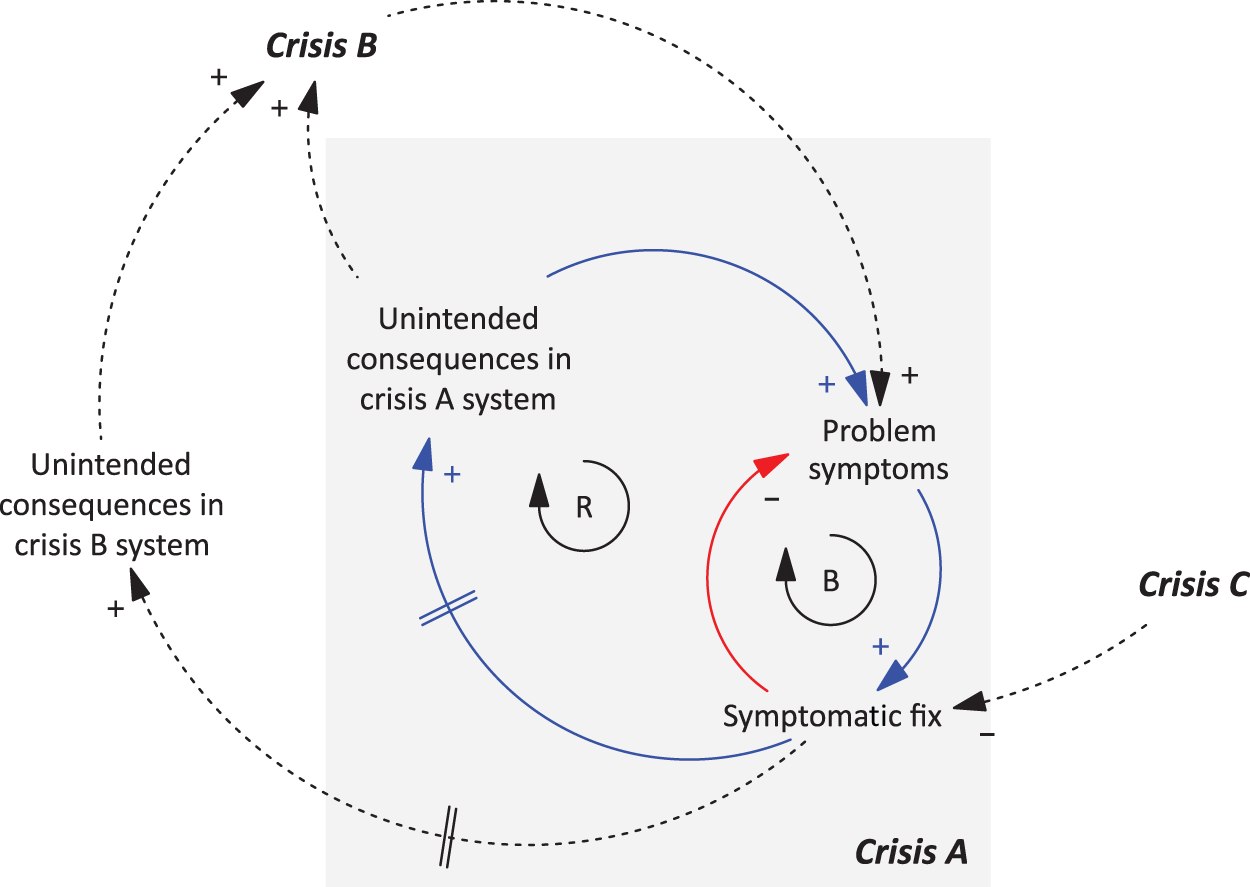
Figure 5. Policy Resistance archetype in a polycrisis context: Crisis Deferral. See the caption for Figure 1 on how to read these diagrams.
To mitigate a Crisis Deferral pattern, solutions must address structural causes rather than focusing on symptomatic improvements. While the latter can play a role in alleviating emergencies, their potential spillover effects on other systems – as well as the risks of triggering new crises or adding new stressors to existing ones – need to be carefully considered. In particular, policy interventions should be wary of a scenario where multiple crises interact in what is referred to as a Shifting the Burden pattern (see Kim & Anderson, Reference Kim and Anderson2007), in which reliance on the symptomatic fix becomes addictive, as it erodes the very capacity needed to address root causes (drug or alcohol addictions are typical examples of this system archetype).
An example of Crisis Deferral is presented in Box 4.
Box 4. Example of Crisis Deferral
Antibiotic overuse and disease resistance, Figure 6
The widespread ‘Use of antibiotics’ (Figure 6) as ‘symptomatic fixes’ to quickly treat ‘Bacterial infections’ (B loop) is driving ‘Antibiotic resistance’ making future infections harder to treat (‘Ability to treat bacterial infections’, R1) and posing significant public health risks (Llor & Bjerrum, Reference Llor and Bjerrum2014). ‘Antibiotic resistance’ intersects with multiple interconnected issues in a polycrisis. For instance, it may lead to a public health crisis to the extent to which increased use and resistant infections decrease ‘Availability of antibiotics in hospitals’ (R3) or increase ‘Treatment costs’ (R4) and ‘Safety of hospitals’, ultimately affecting ‘Public trust in hospitals’, (R5) and leading to delays in seeking care that will in time worsen the overall ‘Public's health’. The rise of antibiotic resistance can further lead to a resurgence of previously controlled diseases (not shown in the figure), complicating the management of pandemics and contributing to the global health crisis. Other subsystems may also be affected by some of these variables, possibly exacerbating existing crises. An overall decrease of ‘Public’s health’ may have important economic consequences (‘Economic crisis’). Increased antibiotic resistance may affect their effectiveness for treating animal diseases, potentially impacting food production (‘Food production crisis’). Conversely, the overuse of antibiotics in livestock for growth promotion and disease prevention contributes significantly to resistance (not shown in diagram). Finally, geopolitical tensions may impact antibiotic supplies, making them unavailable for immediate needs. Antibiotic use as a quick fix to bacterial infections can, via these and other pathways, defer crises in other systems, causing compounding impacts in a polycrisis context.
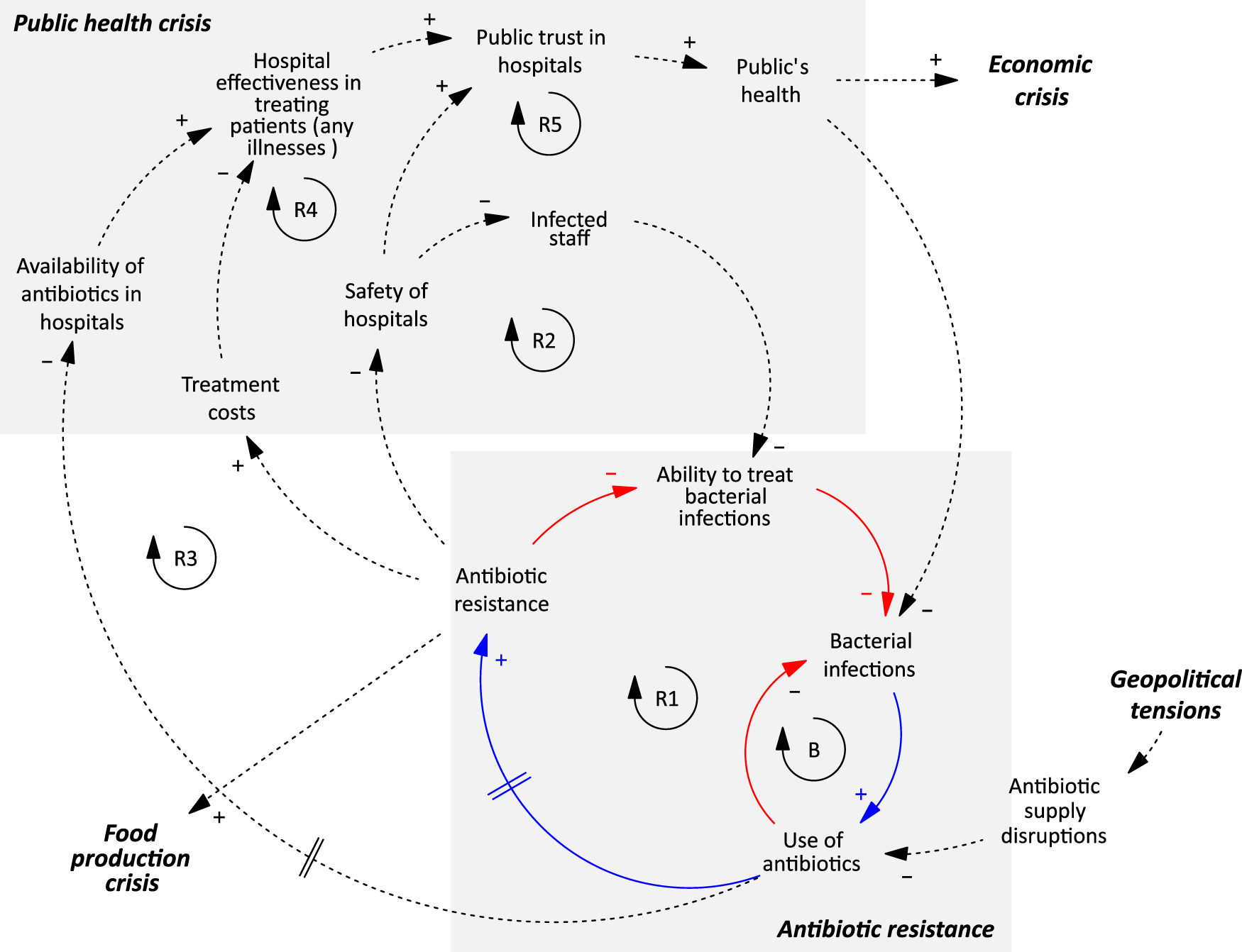
Figure 6. Crisis deferral in the context of antibiotic resistance.
These cascading effects could potentially be avoided by better managing the system archetype underlying the original problem and attempting to address its root causes. Stricter guidelines on antibiotic prescriptions and agricultural use can be enforced, a ‘One Health approach’ that integrates human, animal, and environmental health strategies can be promoted (Mackenzie et al., Reference Mackenzie, Jeggo, Daszak and Richt2013), and international efforts to address antibiotic resistance as a cross-border challenge can be implemented. Further, some of the reinforcing loops in the public health crisis could potentially be mitigated by introducing redundancies or increasing buffer sizes, thereby reducing the rate at which further bacterial infections increase.
4. Discussion
We have exemplified above how system archetypes and the corresponding polycrisis patterns (Table 1) might contribute to enhancing and communicating shared understandings of regional or global polycrises (Janzwood & Homer-Dixon, Reference Janzwood and Homer-Dixon2022). However, solving the global challenges humanity is facing will necessitate going beyond descriptive analyses of observed causal chains, instead bringing to the forefront the political debates on what constitute desired system outcomes and what are legitimate interventions.
Table 1. Summary of the proposed polycrisis concepts
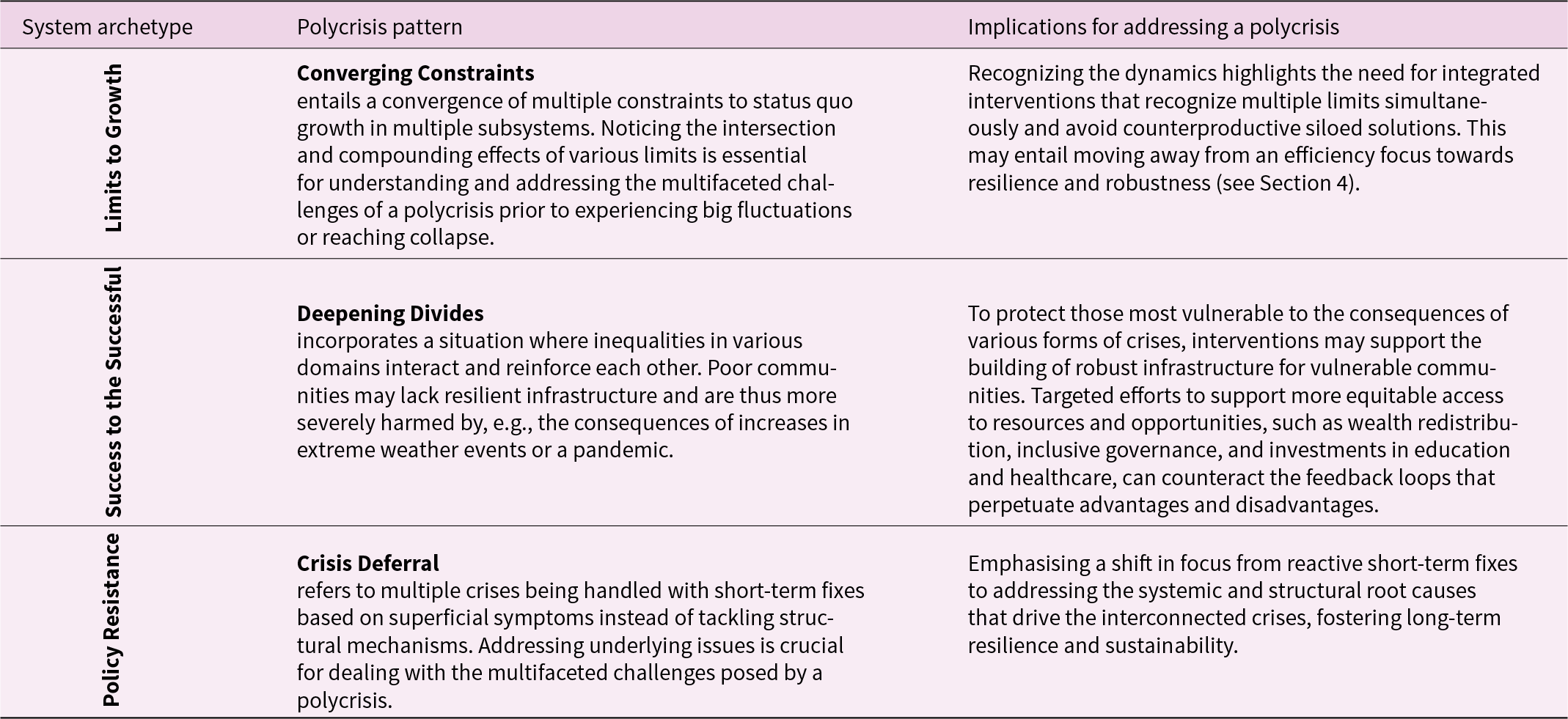
Archetypes can inform us about the behaviours that are likely to emerge given a specific system structure, but offer no guidance on whether the produced behaviour is desirable or not. In contrast, judgements about what constitutes a polycrisis are normative and, therefore, designing policy interventions calls for a critical examination of the paradigms embedded in the structures underlying crises (this incorporates the process of reflecting on and questioning the implicit boundaries that define what is included or excluded in a system's analysis, i.e., boundary critique, see Midgley, Reference Midgley2000). For instance, we argue that a reductionistic mindset and an efficiency-centred paradigm constitute common, meta-level root causes of the archetypical behaviours described above (Hamant, Reference Hamant2024a). Efficiency is attractive because it usually solves issues in the short term (e.g., via optimization). However, it also sets a tempo which becomes a standard and ultimately creates other externalities, for instance by weakening a system’s resilience (Holling, Reference Holling1973; Walker & Salt, Reference Walker and Salt2006). When applied to a polycrisis context, we note that the main threat may not be the lack of response to an initial event or crisis in one subsystem, but that some of the proposed solutions, while seeking efficiency, accelerate the archetypal behaviours that they were set to tackle – like in the case of Policy Resistance (Meadows, Reference Meadows2008) or energy-related rebound effects, when increases in energy efficiency make appliance use more affordable, ultimately increasing energy demand rather than reducing it (Jevons, Reference Jevons1866).
Against the bleak predicament of a global polycrisis, we are consequently reminded that the highest leverage might ultimately be found in changing the goals of the system and transcending the paradigm that created these crises to begin with (Meadows, Reference Meadows2008). One possible such lever is to reconsider the trade-off between efficiency and robustness (which is the first requirement for resilience) in our socio-economic systems (Hamant, Reference Hamant2022), acknowledging that a leading cause of the current polycrisis might be that we have overoptimized our socio-economic systems at the expense of their reliability and viability. In a world marked by rising turbulence and unpredictability, robustness, cooperation, and sufficiency rather than efficiency, competition and growth might provide viable avenues for fostering sustainability.
Even when one might disagree with our contention above, applying the proposed polycrisis patterns is not about finding fixes but helping to dissect the path that has led to the crisis, in order to reveal the root cause of the initial trouble. Leverage points can then be explored to change the behaviour of the system, and its future trajectory. If the problem originates from the deeper structures of a system, then only measures that address those systemic roots can create a lasting improvement. Systemic problems require systemic interventions.
To this end, the polycrisis patterns may also be useful in consultation processes, in so far as they may capture the signals that a situation requires adaptation, enhance the understanding of implications, and could support the co-production of actionable knowledge (Argyris, Reference Argyris1996; Jagannathan et al., Reference Jagannathan, Emmanuel, Arnott, Mach, Bamzai-Dodson, Goodrich, Meyer, Neff, Sjostrom, Timm, Turnhout, Wong-Parodi, Bednarek, Meadow, Dewulf, Kirchhoff, Moss, Nichols, Oldach and Klenk2023).
The polycrisis patterns may also be used to codify behavioural outputs from complex computer simulation models of the future of humankind, specifically system dynamics models such as FRIDA (Schoenberg et al., Reference Schoenberg, Mauritzen, Adakudlu, Ramme, Blanz, Breier, Grimeland, Mashhadi, Jefferson, Wells and Ramme2024), and World3 (Meadows et al., Reference Meadows, Meadows, Randers and Behrens1972, Reference Meadows, Randers and Meadows2004) that have been designed in the same academic tradition. For example, the scenarios in Limits to Growth (Meadows et al., Reference Meadows, Meadows, Randers and Behrens1972) portray Converging Constraints with the intersection of many constraints (including resource limitations and/or pollution), giving the model its characteristic behaviours. Furthermore, without tackling the structural mechanisms that drive the growth in population and material throughput in World3, proposed solutions are characterized by Crisis Deferral dynamics. The use of our polycrisis patterns can further help in communicating the simulation results of future modelling efforts.
5. Conclusion
We have laid out how system archetypes may be used to analyse interdependencies between multiple crises and proposed a set of three polycrisis patterns originating in system archetypes: Converging Constraints (Limits to Growth archetype), Deepening Divides (Success to the Successful archetype), and Crisis Deferral (Policy Resistance archetype). We have proposed generic system structures for the respective polycrisis patterns, and illustrated their application with real-life sustainability challenges. Our examples serve as use cases or proof of concept for how archetypes could be applied to improve understanding and address multiple interdependent crises. Although in this paper we have only proposed a menu of three polycrisis patterns, additional systems archetypes should be incorporated for consideration in future work. These archetypes can also be combined in various ways to better capture the complex dynamics of the global polycrisis.
Paradoxically, though the polycrisis patterns can be considered as vastly simplified versions of systems, they can assist in exploring their complexity, and in particular recognizing what initially may be counterintuitive feedback. By revealing recurring patterns and feedback structures that underlie complex crises, they enable a deeper understanding of their dynamics and the identification of leverage points for more effective interventions.
Viewing the polycrisis through the lens of systems archetypes can uncover deeply ingrained worldviews or ‘traps’ – such as efficiency traps – that reinforce chronic, compounding impacts. From this perspective, the polycrisis is, at its core, a cultural crisis. To navigate it, we must move beyond a misguided fixation on efficiency. Such a narrow efficiency focus may have been well-suited to a stable world with abundant resources. However, today’s increasingly turbulent world calls us to embrace solutions that are intentionally suboptimal – yet more resilient. Polycrisis patterns might provide a useful tool for starting a global bifurcation towards such a new paradigm.
Acknowledgements
The ideas presented in this paper partly evolved in discussions related to the project ‘System Archetypes’ of the Balaton Group. We thank all Balaton Group members for their collegiality and the many thoughtful conversations over the years, which have significantly shaped our understanding of system dynamics and systems thinking. In particular, we thank other members of the System Archetypes project: Dr Anupam Saraph and Dr Cuauhtémoc Leon. We would also like to thank the Fondation des Treilles for wonderfully hosting our project in France. We are grateful to Dr Michael Lawrence from the Cascade Institute for feedback on an earlier draft of this manuscript. We thank Axel Eriksson for insightful comments on the text. Last, but not least, we remain indebted to Prof Dr Dennis Meadows for reviewing our draft manuscript and for inspiring this project with his remarkable insights and unwavering support.
Author contributions
DC initiated the idea and developed a concept note together with CM, OH, and GMM. Conceptualization: all authors; Formal analysis: DC and CA led, all authors contributed. Writing – Original Draft: DC, CA, CM, LBS, JG, OH, and RO; Writing – Review & Editing: CA, DC, OH, BdV, GMM, and LBS. Funding acquisition: GMM, OH, and DC.
Funding statement
The ‘Systems Archetypes’ project is funded by the International Network of Resource Information Centers (‘Balaton Group’), USA, and generously supported by Fondation des Treilles, Tourtour, France. DC acknowledges financial support from Horizon Europe (WorldTrans, grant agreement ID: 101081661) and from the project FAIRTRANS that is funded from Mistra [DIA 2019/28] and from Formas via the national research programme on climate (2021-00416).
Competing interests
The authors declare no conflicts of interest.

